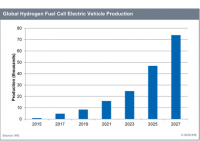Hydrogen Compression
Jump to navigation
Jump to search
OSE Position
OSE proposes a robust economy based on water lubricated internal combustion engines running on hydrogen as a solution for distributed power production - available today using current technology with no new innovation needed outside of social innovation towards acceptance of the possibility.
Info
- Hydrogen Station Compression and Costs from NREL - [1]. Concludes cost of compression, storage, and
- Diaphragm compressor - for hydrogen - [2]
- Piston compressors provide high volume. Easier to do than diaphragm compressors. No need for ultra purity in hydrogen engines. [3]
Low Pressure Storage
- Low pressure hydrogen storage - [4] - NJ demo house.
Companies
- Pure Energy Centre - [5]
Hydrogen Cylinders
- 2000 PSI - 194 cu f (5.5 cu m) [6]
Hydrogen Generator
Separating Generator
- Diagram of system - [7]. Paper has info contacts at NREL, and comparison of PEM to alkaline.
- alkaline electrolyzer stack - price not shown - [8]
- 200 cc/min at 3-8 bar - $9k - [9]. With 1440 minutes/day - or 0.3 cu meter per day [10].
- 1000 cc/min - $3280 - for 1000 ml/min - 1.4 cu meter/day. Alkaline, 4 bar. That is 130 grams of hydrogen per day. [11]
- Redo the same - and 10x lower cost.
- Need 3 hours of Honda EU1000 generator - or 2.7 kWhr.
- 500 cc/min - $700 - [12]
- x5 = $3500 for 2500 cc/min or 3.5 cu m per day (about 1000 gal propane tank) [13]. Or 290 grams per day.
- Power extraction - If 0.6 gal used for 7 hours at 1/4 power with Honda EU1000 - the gen set can do 7 hours at 200W. Or 1.4 kWhr. It advertises 3.2 hours at full power - or nearly 3 kW. Note that 3.2 hours at rated load of 900W - nearly 3 kWhr - on 0.6 gal gas. So it's more efficient to run at full power, which wastes less energy due to 'reciprocating pump loss'.
- Bottom line - 290 grams per day of hydrogen - less than 1/3 kg equivalent - means about one half the 0.6 kg (0.6 gal) equivalent tank of the Honda EU1000. Thus, we get a power of about 1.5 kWhr from the daily generation of hydrogen. Not bad. That is marginal full power storage from an eco-home with smart energy. If designed for smart energy use, then this solar hydrogen route could be completely viable. Using $3500 in hydrogen generation. For storage in a Propane Tank - bottom line is
- Zirfon PERL is common electrolyzer separator material - [14]. It is a polysulfone (3D printable) and 85% ZrO2 nanoparticles blend. ZrO2 - [15]
- Both stainless steel and nickel work as electrodes - [16]
- Alkaline Electrolyzer Design
DIY Separating
- thediyscienceguy@gmail.com - [17]
Mixing Generator
- $200 for 6 lpm - but this is HHO, not H + 0
- Graphite plates work well - [18]
- Wet vs dry cell design - [19]
Demonstration Hydrogen Houses
- Hopewell Project - NJ - [20]. AKA Hydrogen House - [21]
- Scientific American - Oh, only $500k for the off-grid home - [22]
Hydrogen Engines
- https://en.wikipedia.org/wiki/Hydrogen_internal_combustion_engine_vehicle
- Improving the ICE for hydrogen use - [23]
Fuel Cells
- Fuel cell types overview - [24]
- 1kW costs $5k - [25]
- 400W for 8.5k Euro [26]
- $60/W - [27]
- 11k fuel cell cars exist already worldwide, half of them being in California - [28]
- From [29] -

Efficiency and Lifetime
- Efficiency from electrolysis back to electricity in fuel cells is 45% with fuel cells - p. 11 - [30]
- Lifetime of PEM FC is only 2k-4k hours in cars, and 40k in stationary applications. Major issues with longevity! [31]
Fueling Stations
- Cost approximately $1M each. OSE could fund these from proceeds of programmatic revenue in locations of OSE Campuses.